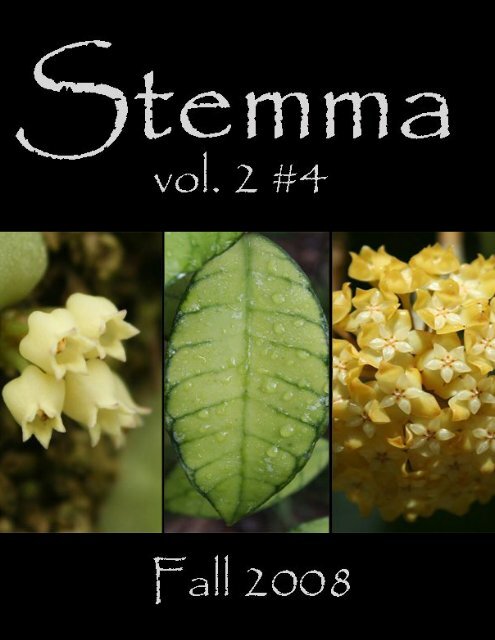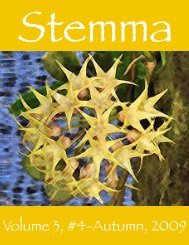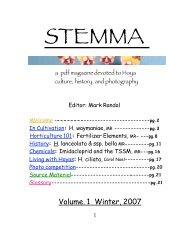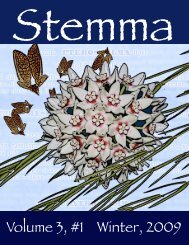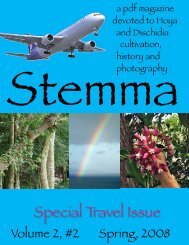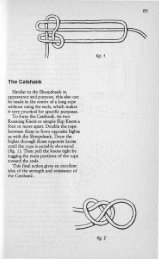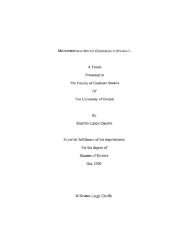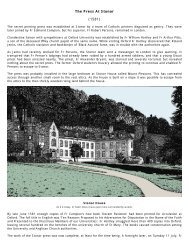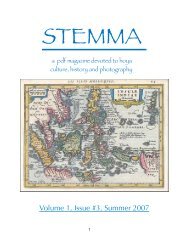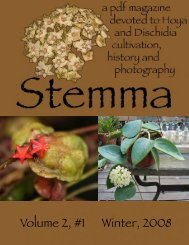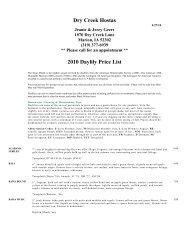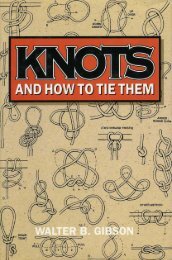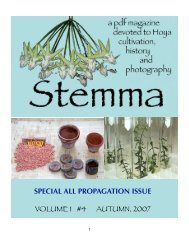(Hoya albiflora Zipp. ex. Blume) from - Cubits
(Hoya albiflora Zipp. ex. Blume) from - Cubits
(Hoya albiflora Zipp. ex. Blume) from - Cubits
Create successful ePaper yourself
Turn your PDF publications into a flip-book with our unique Google optimized e-Paper software.
3 Editor's Note<br />
contents<br />
4 Pockets: Not Only For Jeans by Antone Jones<br />
13 Reprint: Pterostelma albiflorum (<strong>Hoya</strong> <strong>albiflora</strong> <strong>Zipp</strong>. <strong>ex</strong>. <strong>Blume</strong>) <strong>from</strong><br />
Rumphia 4, 1848<br />
14 A look at <strong>Hoya</strong> sections part 2 by Mark Randal<br />
33 Department of Corrections<br />
34 Source Materials<br />
35 Back Page: Dischidia aff. lanceolata IPPS 7385 by Antone Jones<br />
Editor: Mark Randal<br />
Editor of Dischidia Content: Antone Jones<br />
Translation Services: Gerbrand Caspers<br />
Technical Consultant: Bobby Fisher<br />
Stemma Godmother: Carol Noel<br />
Availability: Stemma is available for free download <strong>from</strong> our website,<br />
www.stemmajournal.com. Email notification is available, but with a limit of three hundred<br />
subscriptions. Subscriptions are full at this time.<br />
Posting Stemma for download on unauthorized sites is prohibited.<br />
Usage Policy: Stemma may be distributed freely as a whole by private individuals, but<br />
content and photos remain the intellectual property of the individual contributor and may<br />
not be reproduced separately. Use of any portion of Stemma (including photographic<br />
content) for commercial gain is strictly prohibited.<br />
© Stemma Magazine 2008<br />
2
Editor’s Note<br />
This issue contains an article <strong>from</strong> our Editor of Dischidia content, Antone Jones,<br />
<strong>ex</strong>ploring the phenomenon of “pocket” leaves in Dischidia. Antone maintains a website<br />
devoted to the genus Dischidia at: www.dischidia.com.<br />
The second installment of the article “A look at <strong>Hoya</strong> sections” appears in this issue. The<br />
first installment <strong>ex</strong>plored two major groups of <strong>Hoya</strong> species, one containing compl<strong>ex</strong>es<br />
like Otostemma and Acanthostemma, which have small, ball-shaped flowers formed in<br />
flat clusters, and the other group containing compl<strong>ex</strong>es like the <strong>Hoya</strong> pottsii compl<strong>ex</strong> and<br />
section <strong>Hoya</strong>, which have mostly medium-sized flowers with flat or refl<strong>ex</strong>ed flowers in<br />
rounded clusters. This issue picks up with one more section which might be closest to<br />
section <strong>Hoya</strong>, and then focuses on four species compl<strong>ex</strong>es/sections which seem to form a<br />
third major group of species compl<strong>ex</strong>es epicentered in Australia and New Guinea.<br />
Stemma now has a website: www.stemmajournal.com , where current and past issues<br />
can be downloaded. The website also features pages which list vendors, websites & forums<br />
and on-line literature sources <strong>from</strong> around the world.<br />
Also on the Stemma site is a growing photo gallery in which we are attempting to show<br />
images of the flowers and leaves of every <strong>Hoya</strong> in cultivation. This may take some time,<br />
but we are off to a good start.<br />
Here are a few images <strong>from</strong> the Stemma photo gallery:<br />
3
Pockets: Not Only For Jeans<br />
By Antone Jones<br />
Dischidia vidallii<br />
4
Man was not the first on Earth to make use of the pocket. Sorry Levi, but Mother Nature<br />
beat you to it! As many know, the genus Dischidia contains species with various foliage types.<br />
There are those with normal foliage, those with shell leaved foliage and there are those that grow<br />
both normal and bullate foliage. In this article we will take a look into the bullate (or pocket) leaved<br />
types. What are these structures? What are their functions?<br />
This group of plants in Dischidia currently contains only three species: Dischidia major (Vahl)<br />
Merr., Dischidia vidallii Becc. and Dischidia compl<strong>ex</strong> Griff. All three species produce pocket leaves but<br />
each of them is different and unique on its own. Not only are the pockets different but the normal<br />
foliage and flowers differ greatly as well. They do, however, share some characteristics.<br />
Dischidia major, D. vidallii and D. compl<strong>ex</strong> are all myrmecophilous in nature. This means<br />
that they <strong>ex</strong>ist in harmony with ants, forming a symbiotic relationship with them. In the wild, ants<br />
seek refuge inside the pocket leaves that these plants produce. Soil, larvae and deceased ants have<br />
all been found inside of these structures. The benefit to the ants is clear in that these structures provide<br />
a nesting site. The plants also benefit <strong>from</strong> such a relationship as their roots grow inside of the<br />
pocket leaves and can thus obtain nutrient <strong>from</strong> the ant <strong>ex</strong>crement and detritus. Perhaps the ants<br />
could also provide some degree of protection to the plant <strong>from</strong> would-be predators.<br />
Basically, the pockets are formed when the outer margins of a leaf stop growing while the<br />
center of the leaf continues to grow. As time progresses the leaf margins curl under to close the gap<br />
which creates a small hole. At the point where the petiole meets the pocket leaf, a single root (in D.<br />
major and D. vidallii) or two roots (in D. compl<strong>ex</strong>) enter the cavity. Once inside they branch and<br />
form a complete root system. There have been accounts of large quantities of soil found inside the<br />
pocket leaves of D. major suggesting that not only can these bullate leaves serve as ant homes but<br />
also as a sort of built-in flower pot. It has also been suggested that when the pocket leaves of D. major<br />
grow hanging upside down, they can trap water which would also serve as a way for the plant to<br />
retain moisture in <strong>ex</strong>treme cases of drought. It is not known what <strong>ex</strong>actly triggers the production of<br />
the bullate foliage as some specimens contain many pocket leaves while others contain very few or<br />
none at all. While these are characteristics that are shared between these three species, they do<br />
have a few major differences as well.<br />
Dischidia major (Vahl) Merr. (syn. D.<br />
rafflesiana Wall.) is a widespread and common<br />
species. It occurs <strong>from</strong> NE India all the<br />
way to Australia. In nature, it is often a xeric<br />
species, found growing <strong>ex</strong>posed to the full<br />
sun. D. major is also quite variable. There<br />
are clones which have “normal” pocket<br />
leaves that may average approximately 8cm<br />
long by 3cm wide. This “normal” clone is<br />
the most commonly seen in cultivation and<br />
in some places it is called the “Pickle Vine”.<br />
5<br />
Dischidia major
There are also other clones with very narrow pocket leaves (IPPS 35- pictured to the left), others<br />
with small egg shaped leaves (sometimes called D. lutescens) and even clones with seemingly<br />
gargantuan pocket leaves that are<br />
nearly the size of a potato. D. major<br />
possesses the most simple pocket leaves<br />
of the three species. Its pockets are<br />
simply hollow with no other structures<br />
inside them save for the roots. The<br />
laminate foliage is nearly perfectly circular<br />
and flat with a slight curvature of<br />
the abaxial surface creating an almost<br />
concave area similar to that of the shell<br />
leaved species. The flowers are usually<br />
green with darker green stripes but can<br />
also be yellow to yellow-green. The<br />
adaxial surface of the corolla lobes is<br />
puberulous. They have no smell.<br />
Egg Pocket<br />
Clone<br />
2 clones<br />
comparison<br />
6
Pocket of D. major cut open.<br />
Young pocket leaf forming.<br />
7
D. major flowers, Selby clone.<br />
Flowers <strong>from</strong> a Philippine clone of D. major.<br />
8
Dischidia vidallii Becc. (syn. D. pectenoides) is a very common species found throughout the<br />
Philippine archipelago. Its pocket leaves are often kidney shaped and appear “wrinkly”. This species<br />
is the most common in<br />
cultivation and is often sold<br />
growing <strong>from</strong> large snail<br />
shells. The pockets of D. vidallii<br />
sometimes contain a much<br />
smaller and reduced second<br />
pocket inside of the larger<br />
pocket leaf. The laminate foliage<br />
of this species is small,<br />
somewhat elliptic and often<br />
has some curvature. The flowers<br />
are <strong>ex</strong>tremely vibrant and<br />
pink. The corollas barely open<br />
at anthesis and as such are self<br />
fertile. The follicles are typical<br />
of Dischidia and are needlelike<br />
in shape. (Pocket cut open<br />
and flowers pictured below.)<br />
9
Dischidia compl<strong>ex</strong> Griff. is a very rare species that occurs in Malaya, Borneo and the Philippines.<br />
Its bullate foliage can be round or conical in shape. This species’ pocket leaves contain a<br />
smaller pocket inside.<br />
The laminate<br />
foliage of D. compl<strong>ex</strong><br />
is similar to<br />
that of D. major.<br />
On average they<br />
are smaller than D.<br />
major however.<br />
The flowers are<br />
yellow with white<br />
corolla lobes<br />
which are widely<br />
divergent. The gynostegium<br />
is quite<br />
conspicuous at anthesis.<br />
(Flowers<br />
pictured).<br />
Pocket of D. compl<strong>ex</strong> cut open to show 2nd internal pocket<br />
10
Top: Pocket leaf of D. compl<strong>ex</strong>. Bottom: Normal leaf of D. compl<strong>ex</strong>.<br />
11
The function of the internal pockets in D. vidallii and D. compl<strong>ex</strong> is not quite fully understood.<br />
There have been suggestions that due to the design of the double pocketed leaves, the inner<br />
smaller pocket could provide refuge to ants if the outer pocket were to get flooded. D. vidallii has<br />
been shown to contain small bits of sweet material on the inner wall of the internal pocket leaf<br />
which are a result of decomposition. The ants that inhabit the plant would inevitably consume such<br />
material and therefore it is suggested that the smaller inner pocket could also serve as a feeding<br />
area. More study of these species in situ is needed and until such studies are conducted, we are left<br />
only to speculate.<br />
Cultivating these species can be an enjoyable <strong>ex</strong>perience. Being that they are, for the most<br />
part, xeric and are strictly epiphytes, we should make sure that they have lots of light and get a<br />
chance to dry quite well after being watered. They can be grown mounted or in baskets with <strong>ex</strong>tremely<br />
well draining mixes. Dischidia vidallii and D. major are both quite aggressive and can cover<br />
a trellis in short time. Personally, I have noted that these three species tend to produce the pocket<br />
leaves when allowed to climb and when stressed a bit. Those plants which can not climb and are<br />
fed well tend to only grow the typical foliage. D. vidallii is a consistent bloomer and seems to never<br />
cease blooming no matter the time of year. It is often adorned in buds, flowers, follicles and seed all<br />
at once on the same specimen. D. major and D. compl<strong>ex</strong> are reluctant bloomers for me. Propagation<br />
of these plants is quite easy and is best done with material that does not contain the pockets.<br />
Using material with the pockets tends to rot them which only invites fungus.<br />
A genus of plants with more interesting types of foliage would be hard to find. The pockets<br />
that these plants produce are a beautiful oddity in the plant kingdom. Not only are they intriguing<br />
but they serve a unique purpose and have specific functions that form relationships with creatures of<br />
a completely different kingdom. As time goes on, we can only hope to learn more about their intriguing<br />
adaptations but for now we can enjoy them as they are.<br />
Works Cited:<br />
Rintz, R. E. 1980. “The peninsular Malayan species of Dischidia (Asclepiadaceae)”. <strong>Blume</strong>a 26: 81 --126<br />
Pearson, H. H. W. 1902. “Dischidia with double pitchers”. Journal of the Linnean Society, Botany 35:<br />
375 -- 390<br />
- Antone Jones n<br />
12
Reprint<br />
Pterostelma albiflorum<br />
(<strong>Hoya</strong> <strong>albiflora</strong> <strong>Zipp</strong>. <strong>ex</strong> <strong>Blume</strong>) From Rumphia 4, 1848<br />
PTEROSTELMA Wight. Contrib. bot. of Ind. p. 39. Endl. Gen. Plant. p. 596. no 3502. De Caisne in De Cand. Prodr. Syst. Veg. VIII. p. 633.<br />
Meisn. Plant. Gen. p. 270 et Comment. p. 177. 82.<br />
Calyx of five-parts. Corolla rotate, five parted. Staminal corona five-leaved; leaves membranaceous, laterally refl<strong>ex</strong>ed, conniving,<br />
interior angle produced into an erect and tooth-like point. Anthers terminated in a membrane. Pollinia approximately<br />
erect; retinacula affixed at the back and base. Stigma apiculate. Follicles...--- A half shrub, woody at the base, of Indiae Orientalis<br />
and New Guinea, twining, habitat agreeing with that of <strong>Hoya</strong>; leaves opposite, fleshy; many flowered umbels are axillary<br />
and interpetiolar; flowers large.<br />
1. P. (Rhytistelma) albiflorum Tab. 188 : Leaves elliptic-oblong, cuspidate; umbels with short peduncles; flowers nodding. —<br />
<strong>Hoya</strong> <strong>albiflora</strong> Herb. <strong>Zipp</strong>. — Habitat. In the rocky coastal forests<br />
of New Guinea, a plant of India, with respect to the memory<br />
of honored Wight, perhaps a distinct genus, on account of<br />
the campanulate-rotate corolla and the spongy-fleshy t<strong>ex</strong>ture of<br />
the staminal corona, whose leaflets are somewhat wrinkled,<br />
lower side is longitudinally crested, ap<strong>ex</strong> revolute, sides refl<strong>ex</strong>ed,<br />
interior angles do not meet, and are produced into long, straight<br />
pointed ap<strong>ex</strong>es. A half shrub, twining, glabrous; branches cylindrical,<br />
twisted, thickened and knobby, older stems pale ochre,<br />
rough and with tubercles. Petiole approximately 2.5cm long,<br />
almost canaliculate on top, fleshy. Leaf 4.5 - 8 inches (long), 1<br />
and 2/3 -2.5 inches wide, elliptic-oblong to oblong, with a constricted<br />
cuspidate ap<strong>ex</strong>, base somewhat rounded, t<strong>ex</strong>ture thick<br />
and fleshy, secondary veins not conspicuous, mid-vein on leaf<br />
underside rounded and very prominent, upper side canaliculate<br />
and with warty outgrowths in the basin. Petioles of the peduncle<br />
doubly short, solitary, spreading, thickened, near the ap<strong>ex</strong> covered<br />
with tiny ovate-triangular bracts, many flowered umbels.<br />
Peduncle pedicels doubly long, nodding, thread-like, above<br />
thicker, calyx and corolla slightly pubescent. Calyx nearly, if not,<br />
a third of the corolla, spreading, deeply five-parted, green, at the<br />
inside base somewhat rough; segments oblong-lanceolate, of<br />
equal length,somewhat concave, acute, somewhat keeled. Corolla<br />
campanulate-rotate, divided into five parts, white, centrally<br />
red, segments erect, lobes ovate-lanceolate, acuminate, somewhat<br />
keeled. Staminal corona one third the size of the corolla,<br />
five-leaved, pale straw-yellow, shiny, with a spongey-fleshy t<strong>ex</strong>ture;<br />
leaves set upright, flat, wrinkled, outline oval-oblong, obtuse,<br />
outside middle longitudinally crested, inside above keeled,<br />
ap<strong>ex</strong> revolute, lateral margins above base connivent-refl<strong>ex</strong>ed,<br />
interior angle produced into a long, hollow, involuted, acuminate<br />
point. Anther membrane ovate, obtuse, with, inside, paired<br />
loculis, separated, side by side. Retinaculum rhomboid, horny,<br />
black-brown, longitudinally sulcate, <strong>from</strong> the back (or lower or<br />
outer side) above base emerge two brief, nearly horizontal legs.<br />
Pollinia oblong, compressed, erect, on the outer side a straight<br />
and narrow margin, base glued to the retinacula by a leg. Ovaries<br />
two, follicle-containing, sessile, together circular, densely<br />
pubescent. Styles two, short, together disk-like, pentagonal,<br />
above apiculate, sparsely hairy, anther membranes alternate with<br />
the retinacula, which are set at the angles.<br />
13<br />
-Translated <strong>from</strong> Latin by Mark Randal
A Look at<br />
<strong>Hoya</strong> Sections<br />
part 2<br />
by Mark Randal<br />
In the first part of this article (Stemma V.2, #3) two apparent major groups of compl<strong>ex</strong>es<br />
in the genus <strong>Hoya</strong> were <strong>ex</strong>plored. The first group consisted of sections or compl<strong>ex</strong>es with<br />
revolute corollas, conical coronas, squat, mostly rectangular pollinia, broadly winged translators<br />
with large caudicles, and whose flowers are borne in concave or flat racemes. These characteristics<br />
are most evident in species in sections Acanthostemma, Otostemma, and Peltostemma. The<br />
other major group of compl<strong>ex</strong>es <strong>ex</strong>plored in part one of this article were those species with flat<br />
or refl<strong>ex</strong>ed corollas, roughly horizontal corona tops, oblong pollinia, narrowly winged translators<br />
with tiny caudicles, and whose flowers are borne in conv<strong>ex</strong> racemes, as is most readily seen<br />
in sections <strong>Hoya</strong> and Amblyostemma, and in the <strong>Hoya</strong> pottsii compl<strong>ex</strong>. A number of sections or<br />
compl<strong>ex</strong>es that are possibly intermediate between these two groups were also presented (the<br />
<strong>Hoya</strong> cumingiana compl<strong>ex</strong>, section Angusticarinatae, and the <strong>Hoya</strong> lanceolata compl<strong>ex</strong>).<br />
This portion of the article picks up with one group (The <strong>Hoya</strong> polyneura compl<strong>ex</strong>) which seems<br />
to be most similar to the <strong>Hoya</strong> carnosa compl<strong>ex</strong>, and then focuses on four groups which seem to<br />
form another large group of related species compl<strong>ex</strong>es. These four groups consist of the <strong>Hoya</strong><br />
macgillivrayi compl<strong>ex</strong> (proposed), the <strong>Hoya</strong> patella compl<strong>ex</strong> (proposed) and section Pterostelma<br />
(see “Taxonomical considerations” under the entry for this section), which share several key<br />
morphological traits (similar pollinaria structure, more or less cupped corollas, and coronas with<br />
raised inner angles), as well as section Angustialatus (proposed), whose species may be viewed<br />
as being morphologically intermediate between section <strong>Hoya</strong> and the three other compl<strong>ex</strong>es<br />
listed above.<br />
Recent molecular studies (Wanntorp et. al., 2006a, 2006b) suggest that <strong>Hoya</strong> australis, <strong>Hoya</strong><br />
<strong>albiflora</strong> and <strong>Hoya</strong> calycina, one or more of which which have been included in genus or section<br />
Pterostelma in most modern sectional schemes (<strong>Blume</strong>, 1848; Schlechter, 1914; Kloppenburg,<br />
1993), share a close evolutionary history with <strong>Hoya</strong> macgillivrayi, <strong>Hoya</strong> patella and <strong>Hoya</strong><br />
venusta, campanulate species previously grouped into section Cystidianthus (or its synonym,<br />
section Physostelma) with <strong>Hoya</strong> campanulata (Schlechter, 1914; Kloppenburg, 1993; Burton,<br />
1995/96). These species correspond to sections 14-16 presented here.<br />
14
Also placing into a clade with H. australis, H. macgillivrayi and H. patella (called the “Australia/<br />
New Guinea clade” by Wanntorp et. al., 2007) were <strong>Hoya</strong> inflata and <strong>Hoya</strong> hypolasia. Wanntorp<br />
et. al. hypothesized that these species share a common evolutionary history which diverges<br />
<strong>from</strong> the mass of <strong>Hoya</strong> species. Wanntorp (2007) also showed a distinct, shared pollinarium<br />
structure which corroborates the close relation of all species included in the “Australia/ New<br />
Guinea clade”. Common pollinarium elements presented as uniting these species included a<br />
distinct bump at the lower, outer margin of the pollinia shortly above their union with the translators<br />
and/or caudicles, and relatively broad (or ovate) corpuscula (as compared to those species<br />
included in any of the groups previously studied in part one of this article).<br />
A microphotographic series comparing the pollinaria of section <strong>Hoya</strong> and <strong>Hoya</strong> pottsii compl<strong>ex</strong> species (top)<br />
with species in the “Australia/New Guinea clade” (bottom). <strong>Hoya</strong> lamingtoniae, not studied in Wanntorp, 2006a,<br />
2006b, 2007 is included here with the latter group, but was not linked to this group by those studies.<br />
The differences are subtle, but consistent. The pollinaria of those species related to <strong>Hoya</strong> carnosa and <strong>Hoya</strong> pottsii<br />
have proportionally slimmer corpuscula, the species in the “Australia/New Guinea clade” have proportionally<br />
broader corpuscula and a small bump at the outer, lower pollinia margin just above their junction with the translators.<br />
This bump seems to be less conspicuous in section Angustialatus species, which may form a genetic link between<br />
the two groups.<br />
Top row, L-R: H. carnosa, H. pottsii, H. acuta, H. pubicalyx, H. cinnamomifolia.<br />
Bottom row, L-R: H. calycina, H. onychoides, H. odorata, H. patella, H. lamingtoniae (PNG-4).<br />
Photo of H. patella pollinarium courtesy of Torill Nyhuus,<br />
photos of H. odorata & H. lamingtoniae pollinaria by Dale Kloppenburg.<br />
15
The Wanntorp studies of 2006 do not include any species classified here as belonging to Burton’s<br />
proposed section Angustialatus, but as these species share the geographical distribution of<br />
those species in the “Australia/ New Guinea clade” and there appear to be intergrades or hybrid<br />
species which share morphological characteristics between Angustialatus and two of the three<br />
other main groups contained in the “Australia/ New Guinea clade”, it is hypothesized here that<br />
these four groups share an evolutionary history which separated relatively early in the genus’<br />
history <strong>from</strong> the other species groups <strong>ex</strong>plored in part one of this article.<br />
__________________________________________________________<br />
Since the publication of the first portion of this article two prime criticisms of sectional theory<br />
have been advanced by several Stemma readers: 1) the sections are “unnatural” and 2) many species<br />
may be placed in more than one section, suggesting that the sections as presented are arbitrary<br />
or unacceptably imprecise.<br />
The first criticism may be taken as referring to the terminology of “unnatural” and “natural”<br />
groupings in taxonomy, used to designate whether described groups constitute genuinely closely<br />
related species (“natural”) or groups which are based on arbitrary traits which do not denote a<br />
close genetic relationship (“unnatural”). One <strong>ex</strong>ample of a group considered “natural” is subfamily<br />
Asclepiadoideae in family Apocynaceae. Asclepiadoideae are characterized by (among other<br />
traits) having radially symmetrical flowers with parts in groups of five and pollen structures formed<br />
by the connection of two waxy bundles of pollen. The genera included in Asclepiadoideae are accepted<br />
as being more closely related to one another than to species not included in this group, a<br />
hypothesis supported by modern molecular testing, and so are considered a “natural” group. An<br />
<strong>ex</strong>ample of an “unnatural” group would be one which classifies all plants with red flowers as one<br />
group. This grouping is considered “unnatural”, as the characteristic of having red flowers occurs<br />
in many disparate unrelated genera across the range of flowering plants.<br />
The history of infrageneric classification of <strong>Hoya</strong> has based groupings on characteristics such as<br />
corolla and corona structure and orientation, pollinarium structure and vegetative morphology, all<br />
traits regarded by modern scientists as being relevant to species classification (Rintz, 1978; Kloppenburg,<br />
1993; Burton, 1995/96; Wanntorp, 2006a,2006b,2007). As some species groups (Acanthostemma,<br />
Eriostemma, Angusticarinatae) were corroborated by recent molecular testing (Wanntorp<br />
et. al., 2006a, 2006b), it seems that at least some of the traits used to date to attempt classification<br />
within <strong>Hoya</strong> may be judged as yielding “natural” groupings.<br />
The second criticism mentioned of the sections, that they may be arbitrary since some species<br />
may be placed in more than one group, seems to be based on the idea that the sections/compl<strong>ex</strong>es<br />
should be sharply defined and inviolable, with no interconnections amongst them. Judged by this<br />
standard, the sections do fall short.<br />
However, this standard may not be practical for dealing with sections or compl<strong>ex</strong>es which seem<br />
to be inter-related, and for a genus which seems to speciate rapidly (an idea which has been advanced<br />
to this author by more than one prominent botanist). The compl<strong>ex</strong>es presented in this article<br />
represent some well-defined groups of morphologically similar species, but there are many<br />
species which share traits of 2 or more species groups as defined here. For instance, <strong>Hoya</strong> kloppenburgii<br />
T. Green has the bilobed coronal <strong>ex</strong>tensions characteristic of those species placed in section<br />
Acanthostemma and also has the coronal skirt characteristic of those species placed in section<br />
Otostemma. Section Physostemma species, to be presented in the n<strong>ex</strong>t installment of this article,<br />
have morphological characteristics of both sections Pterostelma and Plocostemma, although the<br />
species placed in each of these three sections share enough unique morphological characteristics<br />
to consider them all as distinct, but related, compl<strong>ex</strong>es.<br />
16
The fact that there are some species which seem to be borderline to some established sections<br />
(<strong>Hoya</strong> serpens is quite similar to section <strong>Hoya</strong> species, enough so to link it to those species, but<br />
it differs in some key traits) or which represent traits of two established sections, does not negate<br />
the sectional divisions themselves where they are well established- it only highlights the fact that<br />
these groups in many cases seem to be inter-connected, in that they may have evolved <strong>from</strong> a<br />
common ancestral group and still retain some shared traits, and/or that hybridization between<br />
the two groups <strong>ex</strong>ists. Borderline species, species which straddle sectional divisions, and<br />
anomalous species, which seem to bear no close relation to any other discovered species, are to<br />
be <strong>ex</strong>pected to occur in nature, as inconvenient as those species may be in attempting to establish<br />
iron-clad sectional divisions.<br />
There has been some debate about the validity of some sectional names presented in this article,<br />
particularly for the name Pterostelma (see that entry for details). One focus of this article is<br />
to present the sections as they have been viewed by previous authors (while noting some of the<br />
ambiguities that accompany these early publications), so where possible previously wellaccepted<br />
compl<strong>ex</strong> names are retained.<br />
The system of naming plant groups which is governed by the International Code of Botanical<br />
Nomenclature (ICBN) is intended to provide a common framework and promote consistency in<br />
taxonomic efforts. However, structure should not be confused with substance. Whether the species<br />
currently associated with the name Pterostelma should be called by that name, the name<br />
Pseudopterostelma, “The <strong>Hoya</strong> <strong>albiflora</strong> compl<strong>ex</strong>” or another name, the species included in this<br />
group share enough similar morphological characteristics that we may make an educated guess<br />
that they are closely related species that have derived <strong>from</strong> a common ancestral species. It is<br />
important to remember that this kind of recognition of species compl<strong>ex</strong>es is the main goal of infrageneric<br />
classification. Taxonomy is important as well, but taxonomic argument is secondary<br />
here to the comparison of species and the theories of their inter-relatedness.<br />
About the suggested section/compl<strong>ex</strong> entries:<br />
Photo credits are as stated. Where no photographer is cited the photo is by Mark Randal.<br />
Some approximate size parameters for floral/ vegetative descriptions in the n<strong>ex</strong>t section:<br />
Leaves:<br />
small- less than 4 cm long and 2.5cm wide.<br />
medium- between 4 and 10cm long, between 2.5 and 7 cm wide.<br />
large- between 10 and 20cm long, between 7 and 10cm wide.<br />
giant- over 20cm long and over 10cm wide.<br />
Flowers (measured in diameter when pressed flat):<br />
small- less than 1cm.<br />
medium- between 1 and 2cm.<br />
large-between 2 and 3cm.<br />
giant- over 3cm.<br />
17
12- The <strong>Hoya</strong> polyneura compl<strong>ex</strong> (proposed)<br />
Overall form: these species are terrestrial or epiphytic sub-shrubs which do not seem to twine.<br />
Leaves are small to medium sized. Medium sized flowers are borne in relatively small clusters<br />
on short peduncles under close-set leaf pairs.<br />
Distribution: possibly eastern India through southern China, apparently not <strong>ex</strong>tending much farther<br />
south than northern Thailand.<br />
Publication: not officially published in this form.<br />
Original description: none.<br />
Revised descriptions: none.<br />
Salient features:<br />
Pollinarium: not enough samples of the pollinaria of these species have been studied by this<br />
author for him to present any findings.<br />
Corona: inner corona lobes acute and upright, outer lobes rounded and horizontal. Overall<br />
shape of segments are oval when viewed <strong>from</strong> above.<br />
Corolla: pubescent, lobes are refl<strong>ex</strong>ed, margins and ap<strong>ex</strong>es are revolute.<br />
Raceme: conv<strong>ex</strong>.<br />
Species thought to belong to this section/compl<strong>ex</strong>:<br />
<strong>Hoya</strong> polyneura Hook. f. (type) <strong>Hoya</strong> lobbii Hook. f. <strong>Hoya</strong> fusca Wall. (?)<br />
<strong>Hoya</strong> pandurata Tsiang<br />
Taxonomic considerations: this is a hypothetical grouping which requires much further study<br />
to confirm. The distinctly non-twining nature of these plants, coupled with certain broad similarities<br />
in peduncle, corolla and corona structure argue a close genetic relationship.<br />
The status of <strong>Hoya</strong> fusca is uncertain in regards to this hypothetical grouping. If this species<br />
does prove to belong grouped here, the name of this compl<strong>ex</strong> should more properly be “the<br />
<strong>Hoya</strong> fusca compl<strong>ex</strong>”, as <strong>Hoya</strong> fusca is the earliest published of the species grouped here to<br />
date.<br />
These species (based on the incomplete current evidence) seem to be most closely related to<br />
those species in section <strong>Hoya</strong>, but have certain similarities to some <strong>Hoya</strong> <strong>albiflora</strong> relatives.<br />
18
The <strong>Hoya</strong> polyneura compl<strong>ex</strong>. 1) <strong>Hoya</strong> lobbii. 2) <strong>Hoya</strong> lobbii, showing peduncle placement and<br />
non-twining growth. 3) <strong>Hoya</strong> polyneura. 4) <strong>Hoya</strong> fusca. 5) <strong>Hoya</strong> lobbii, close-up of corona. 6)<br />
<strong>Hoya</strong> pandurata (photo courtesy of Dr. Piyakset Suksatan). 7) <strong>Hoya</strong> polyneura (photo courtesy of<br />
Ted Green & Green: Plant Research).<br />
19
13- Section Angustialatus C. M. Burton (proposed)<br />
Etymology: “angusti”=”narrow”,L.,”alatus”=”winged”,L.<br />
Type species: <strong>Hoya</strong> flavescens Schltr.<br />
Overall form: twining, epiphytic vines with thin-t<strong>ex</strong>tured medium to large-sized leaves and thin,<br />
wiry stems. Not as vigorous as most <strong>Hoya</strong> pottsii compl<strong>ex</strong> species. Sap is milky. Flowers are<br />
small (<strong>Hoya</strong> ischnopus) to large (<strong>Hoya</strong> chlorantha). Flower color varies <strong>from</strong> chartreuse (H.<br />
chlorantha) to mauve (<strong>Hoya</strong> vitiensis, <strong>Hoya</strong> rubida), but most species closely related to H.<br />
flavescens have yellow flowers which range <strong>from</strong> pale yellow to a dark tawny gold. Some species<br />
placed here (H. chlorantha) seem to lack fragrance, but many species closely related to H.<br />
flavescens have an intense, fruity odor similar to mango or melon.<br />
Distribution: the epicenter of this species compl<strong>ex</strong> seems to be New Guinea.<br />
Publication: Proposed in The <strong>Hoya</strong>n V.17#3(2):17<br />
Original description: “Foliage papery to fleshy; sap milky; corolla lobes usually almost flat, but<br />
sometimes refl<strong>ex</strong>ed, often with more or less revolute margins; corona lobes more or less flat;<br />
pollinia keeled on outer margins; translators not apparently winged, though there appears to be<br />
a very narrow “keel” along the outer margins of the otherwise almost transparent translators.<br />
Most of the hoyas in this group are hoyas that Schlechter placed in his Physostelma section,<br />
where they definitely do not belong. Some, he included in his Eu<strong>Hoya</strong> section.”<br />
Revised descriptions: none.<br />
Salient features:<br />
Pollinarium: translators are narrow. The pollinia of all species <strong>ex</strong>amined by this author (only<br />
three) have a slight bump on the lower, outer surface of each pollinia, a trait which is also present<br />
in all species <strong>ex</strong>amined of the H. patella, H. macgillivrayi and H. <strong>albiflora</strong> compl<strong>ex</strong>es, but<br />
appears to be less pronounced in section Angustialatus species than in those three compl<strong>ex</strong>es.<br />
Corona: similar to those of section <strong>Hoya</strong> species, but with more rounded edges to the upper<br />
corona lobe margins, and with the lobes broadly concave on top.<br />
Corolla: rotate, pubescent, with recurved margins, much like those of the section <strong>Hoya</strong> species.<br />
Raceme: conv<strong>ex</strong> to globular.<br />
Species thought to belong to this section/compl<strong>ex</strong>:<br />
<strong>Hoya</strong> flavescens Schltr. (type) <strong>Hoya</strong> chlorantha Rechinger <strong>Hoya</strong> dennisii P.I.Forst. & Liddle<br />
<strong>Hoya</strong> dimorpha F. M. Bailey <strong>Hoya</strong> dischorensis Schltr. <strong>Hoya</strong> globulifera <strong>Blume</strong><br />
<strong>Hoya</strong> ischnopus Schltr. <strong>Hoya</strong> kenejiana Schltr. <strong>Hoya</strong> lamingtoniae F. M. Bailey<br />
<strong>Hoya</strong> montana Schltr. <strong>Hoya</strong> rubida Schltr. <strong>Hoya</strong> trigonolobus Schltr.<br />
<strong>Hoya</strong> vitiensis Turill<br />
20
Taxonomic considerations: these species, many described by R. Schlechter (1914), were originally<br />
grouped by him into sections Physostelma (a synonym for section Cystidianthus) or <strong>Hoya</strong>. C. M.<br />
Burton proposed section Angustialatus as a home for these species. Of the four theoretically<br />
closely related groups presented here as compl<strong>ex</strong>es 13-16, Angustialatus seems to be closest to<br />
the <strong>Hoya</strong> carnosa and <strong>Hoya</strong> pottsii compl<strong>ex</strong>es. Indeed, all of the traits of <strong>Hoya</strong> flavescens and its<br />
allies can be found in the species included in the H. pottsii compl<strong>ex</strong> or section <strong>Hoya</strong>: rotate, pubescent<br />
corollas with recurved margins (most section <strong>Hoya</strong> species); more or less flat coronas<br />
without a prominent rise to the inner corona lobes (most <strong>Hoya</strong> pottsii compl<strong>ex</strong> species); milky sap<br />
(<strong>Hoya</strong> pottsii compl<strong>ex</strong> species) and somewhat hard, non-succulent leaves (<strong>Hoya</strong> finlaysonii subcompl<strong>ex</strong><br />
species). These similar morphological characteristics suggest that there may be a genetic<br />
link between these groups, but molecular testing on specific groups would be needed to potentially<br />
corroborate this theory.<br />
The article “Wax plants disentangled...” (Wanntorp, 2006a) provides molecular evidence that sections<br />
14-16, the <strong>Hoya</strong> patella, <strong>Hoya</strong> macgillivrayi and <strong>Hoya</strong> <strong>albiflora</strong> compl<strong>ex</strong>es are closely related<br />
(they are referred to by Wanntorp et al. as the “Australia/New Guinea clade”). There is also morphological<br />
evidence to support this hypothesis, as these groups share some unique pollinaria traits<br />
(see entry for “Pollinarium”, above). This group of plants, section Angustialatus, did not have any<br />
representative species included in the Wanntorp studies, and so molecular evidence regarding the<br />
relation of this group to the others included in the “Australia/New Guinea clade” was not advanced<br />
there. However, there is morphological evidence which suggests a genetic link between<br />
Angustialatus and the other groups considered here. Species with characteristics of section Angustialatus<br />
species and two of the other three species compl<strong>ex</strong>es <strong>from</strong> the “Australia/New Guinea<br />
clade” are present within the apparent boundaries of these three sections. <strong>Hoya</strong> denisii (included<br />
here in section Angustialatus) has a cupped corolla and raised inner corona lobes resembling<br />
those of <strong>Hoya</strong> patella compl<strong>ex</strong> species, <strong>Hoya</strong> chlorantha (included here in section Angustialatus)<br />
has corona segments with raised ap<strong>ex</strong>es and inner angles reminiscent of those species in the <strong>Hoya</strong><br />
<strong>albiflora</strong> compl<strong>ex</strong>. <strong>Hoya</strong> subcalva (<strong>Hoya</strong> sp. HSI BSI-1- included tentatively here in the <strong>Hoya</strong> <strong>albiflora</strong><br />
compl<strong>ex</strong>) also seems to have characteristics of both section Angustialatus and the <strong>Hoya</strong> <strong>albiflora</strong><br />
compl<strong>ex</strong>. Given the many intergrades which seem to occur among these four compl<strong>ex</strong>es, it is<br />
assumed for the purposes of this article that they all four share a linked evolutionary history.<br />
An <strong>ex</strong>ample of one possible connection between section Angustialatus and the <strong>Hoya</strong> <strong>albiflora</strong> compl<strong>ex</strong>: <strong>Hoya</strong> subcalva (H.<br />
sp. HSI BSI-1) (center) shares traits with both section Angustialatus species (like <strong>Hoya</strong> rubida, left) and <strong>Hoya</strong> <strong>albiflora</strong> compl<strong>ex</strong><br />
species (like <strong>Hoya</strong> australis, right).<br />
21
Section Angustialatus (proposed). 1) <strong>Hoya</strong> chlorantha (photo courtesy of Bob Ely). 2) <strong>Hoya</strong><br />
dennisii (photo courtesy of Eva-Karin Wiberg). 3) A pollinarium of <strong>Hoya</strong> ischnopus (photo courtesy<br />
of Dale Kloppenburg). 4) A pollinarium of <strong>Hoya</strong> lamingtoniae (PNG-4) courtesy of Dale<br />
Kloppenburg. 5) pollinarium of <strong>Hoya</strong> chlorantha (photo courtesy of Dale Kloppenburg). 6) <strong>Hoya</strong><br />
globulifera (photo courtesy of Surisa Somadee & thailandhoyaclub.com). 7 & 8) corona of <strong>Hoya</strong><br />
vitiensis (photos courtesy of Laila Jansson and the Swedish <strong>Hoya</strong> Society). 9) <strong>Hoya</strong> kenejiana.<br />
22
14: The <strong>Hoya</strong> patella compl<strong>ex</strong> (proposed)<br />
Overall form: these species tend to be epiphytic twining vines of smaller stature than their apparent<br />
close relatives in the macgillivrayi compl<strong>ex</strong>. Leaves are medium to small sized, generally<br />
thin-t<strong>ex</strong>tured. Stems are wiry and thin. Flowers are large, widely and shallowly cup-shaped.<br />
Distribution: Melanesia.<br />
Publication: unpublished in this form.<br />
Original description: none.<br />
Revised descriptions: none.<br />
Salient features:<br />
Pollinarium: only a few pollinarium <strong>from</strong> these species were available to the author for study. It<br />
was reported (Wanntorp, 2007) that the pollinarium of <strong>Hoya</strong> venusta and <strong>Hoya</strong> patella (placed<br />
in this compl<strong>ex</strong>) resemble the pollinaria of <strong>Hoya</strong> <strong>albiflora</strong> and <strong>Hoya</strong> macgillivrayi, having slight<br />
bumps on the outer pollinium base adjacent to the translator junction. This trait seems to unite<br />
sections Angustialatus and Pterostelma with the <strong>Hoya</strong> patella and macgillivrayi compl<strong>ex</strong>es, but<br />
further study and comparison is needed.<br />
Corona: appears ovate <strong>from</strong> above. Inner angles are acute and raised, outer angles are rounded<br />
and horizontal. The upper lobe surface is concave.<br />
Corolla: widely cup-shaped, tending to be wider and more shallow than the corollas of species<br />
grouped in this article in section Cystidianthus with <strong>Hoya</strong> campanulata.<br />
Raceme: conv<strong>ex</strong>.<br />
Species thought to belong to this section/ compl<strong>ex</strong>:<br />
<strong>Hoya</strong> patella Schltr. (type) <strong>Hoya</strong> gildingii D. Kloppenburg <strong>Hoya</strong> megalantha Turril<br />
<strong>Hoya</strong> nyhuusiae D. Kloppenburg <strong>Hoya</strong> venusta Schlechter (?)<br />
Taxonomic considerations: these species have been traditionally included in sections Cystidianthus<br />
(syn. Physostelma) whose type is <strong>Hoya</strong> campanulata, whose species differ <strong>from</strong> the species<br />
included here in the <strong>Hoya</strong> patella group in corolla detail (the corolla lobes of the section Cystidianthus<br />
species are almost entirely fused, with only a minute ap<strong>ex</strong> and sinus, while the species<br />
grouped with H. patella have mostly fused petals with distinct, often refl<strong>ex</strong>ed ap<strong>ex</strong>es), pollinarium<br />
structure (the pollinaria of section Cystidianthus species have rounded pollinia ap<strong>ex</strong>es and<br />
broad translators, while the pollinaria of the H. patella compl<strong>ex</strong> species appear to have very narrow<br />
translators and their pollinia have squared, inwardly angled ap<strong>ex</strong>es) and overall form (the<br />
section Cystidianthus species are terrestrial and bushy when young, the H. patella compl<strong>ex</strong> species<br />
seem to lack this shrubby juvenile habit).<br />
<strong>Hoya</strong> archboldiana, in the <strong>Hoya</strong> macgillivrayi compl<strong>ex</strong>, has a broad campanulate corolla similar<br />
to the species place here with H. patella, but the corona of H. archboldiana is <strong>ex</strong>tremely similar<br />
to that of H. macgillivrayi.<br />
There are many other New Guinean species named by Schlechter (1914) that may belong here.<br />
Schlechter’s drawings of floral parts are rather poorly detailed, however, so that study of live material<br />
would be necessary to place any of these species here. Unfortunately, many of these interesting<br />
species remain un-recollected.<br />
23
The <strong>Hoya</strong> patella compl<strong>ex</strong>. 1) <strong>Hoya</strong> sp. aff. megalantha (bottom three flowers) compared with a<br />
single flower of <strong>Hoya</strong> patella (top) (photo courtesy of Torill Nyhuus). 2) <strong>Hoya</strong> patella (photo<br />
courtesy of Eva-Karin Wiberg. 3) Pollinarium of <strong>Hoya</strong> patella (photo courtesy of Torill Nyhuus). 4<br />
& 5) Corona of <strong>Hoya</strong> sp. aff. megalantha (photo courtesy of Torill Nyhuus & the Swedish <strong>Hoya</strong><br />
Society). 6 & 7) The corona of <strong>Hoya</strong> patella. 8) <strong>Hoya</strong> nyhuusiae (photo courtesy of Torill Nyhuus).<br />
24
15: The <strong>Hoya</strong> macgillivrayi compl<strong>ex</strong> (proposed)<br />
Overall form: these species are vigorous twiners that strive to climb into strong sunlight. Leaves<br />
are large, thick, dark green, and of an elongated cordate shape. Internodes are generally quite<br />
long, sometimes to over 30cm (12”). Flower size is large to giant. Flower corolla color varies,<br />
even within collections of each species, <strong>from</strong> a dark blackish-purple through true reds to bright<br />
magentas. The fragrance of the flowers of these species is intense, sometimes described as cloying.<br />
Distribution: New Guinea and Australia.<br />
Publication: this group of species has not been technically published as a section.<br />
Original description: none.<br />
Revised descriptions: none.<br />
Salient features:<br />
Pollinarium: translators are narrow. The base of each pollinium has a small, slightly angled protrusion<br />
at their outer margin, as in section Angustialatus, the <strong>Hoya</strong> patella compl<strong>ex</strong> and the<br />
<strong>Hoya</strong> <strong>albiflora</strong> compl<strong>ex</strong>.<br />
Corona: the coronas of all of the species presented here have a prominent, rocket-like central<br />
rise, with the median corona lobes being linear, and having a squared-off, upturned ap<strong>ex</strong>.<br />
Corolla- <strong>Hoya</strong> archboldiana has petals that are fused together to nearly the ap<strong>ex</strong> with brief<br />
revolute tips, forming a campanulate corolla, while the other species included here have petals<br />
which separate not far <strong>from</strong> the corona and are flattened-campanulate.<br />
Raceme- loosely conv<strong>ex</strong>.<br />
Species thought to belong in this section/compl<strong>ex</strong>:<br />
<strong>Hoya</strong> macgillivrayi F.M. Bailey (type) <strong>Hoya</strong> archboldiana Norman <strong>Hoya</strong> onychoides P. I. Forster & D.<br />
Liddle & I. M. Liddle<br />
Taxonomic considerations: these species have been included in section Cystidianthus (syn.<br />
Physostelma) by various authors (Schlechter, 1914; Kloppenburg, 1993; Burton 1995/96). The<br />
type species for section Cystidianthus is <strong>Hoya</strong> campanulata, a species with a similarly shaped<br />
corolla to <strong>Hoya</strong> archboldiana, but with different corolla, corona and pollinarium details and a<br />
different overall form (see the entry for the <strong>Hoya</strong> patella compl<strong>ex</strong>, under Taxonomic considerations).<br />
A number of other <strong>Hoya</strong> species are linked to this larger group (sections 13-16) of apparently<br />
related compl<strong>ex</strong>es. <strong>Hoya</strong> megalaster is linked by a close vegetative and pollinarium structure to<br />
those species in the <strong>Hoya</strong> macgillivrayi compl<strong>ex</strong>, and <strong>Hoya</strong> inflata and <strong>Hoya</strong> hypolasia are also<br />
linked to this group by certain vegetative features (elongated cordate leaves), pollinaria details<br />
(all share the wide corpuscula and protruding outer pollinia bases characteristic of these sections),<br />
and H. hypolasia and H. inflata have also been linked by molecular and pollinarium findings<br />
<strong>from</strong> the Wanntorp (2006a, 2006b, 2007) studies.<br />
These three species have widely varying details of their corolla and corona, however, and so it<br />
does not seem possible to place them definitively in any of the compl<strong>ex</strong>es discussed here, although<br />
they seem to share most morphological similarities with species placed in the <strong>Hoya</strong><br />
macgillivrayi compl<strong>ex</strong>.<br />
25
The <strong>Hoya</strong> macgillivrayi compl<strong>ex</strong>. 1 & 2) <strong>Hoya</strong> macgillivrayi (photos courtesy of Doug Chamberlain).<br />
3) corona of <strong>Hoya</strong> onychoides. 4) side view of corona of H. onychoides. 5) Pollinarium of<br />
H. onychoides. 6) H. onychoides. 7) Pollinarium of H. archboldiana (photo courtesy of Dale<br />
Kloppenburg). 8) <strong>Hoya</strong> archboldiana (photo courtesy of Monina Siar).<br />
26
16: The <strong>Hoya</strong> <strong>albiflora</strong> compl<strong>ex</strong> (section Pterostelma (Wight) Hooker f.)<br />
Etymology: “pteron”=”wing”, Gr., “stelma”=”crown”,Gr.<br />
Type species: <strong>Hoya</strong> <strong>albiflora</strong>. (For section Pterostelma, the type species would be <strong>Hoya</strong> acuminata.)<br />
Overall form: these species are mostly vigorous epiphytic or partly terrestrial twiners that often<br />
strive to climb into strong sunlight. Leaves are medium to large, occasionally giant, rarely small,<br />
thin to succulent, often slightly cordate in shape. Flowers generally are medium to large-sized<br />
and have white, deeply divided and slightly cupped corollas. Coronas vary in color. Most species<br />
are intensely fragrant.<br />
Distribution: the epicenter of this compl<strong>ex</strong> of species seems to be New Guinea, but outlying<br />
species occur in Australia (several <strong>Hoya</strong> australis ssp.s), to Samoa in the east (H. australis ssp.<br />
tenuipies) and at least as far north as northern Thailand (<strong>Hoya</strong> thailandica). Possibly into Bangladesh<br />
if <strong>Hoya</strong> acuminata does properly belong to this compl<strong>ex</strong>, which is not clear at this time.<br />
Publication: Contributions to the Botany of India, Robert Wight, 1834 (as a genus), The Flora of<br />
British India, J. D. Hooker, 1885 (as a section).<br />
Original description (for genus Pterostelma): (translated <strong>from</strong> Latin by MR) “Corolla rotate, fiveparted.<br />
Staminal corona five-leaved; leaves membranaceous sides refl<strong>ex</strong>ed, interior angle subulate,<br />
erect, tooth-like. Anthers terminated in a membrane. Pollinia masses approximately erect,<br />
corpuscula affixed at the back and base. Stigma apiculate. - Twining shrub ? or decumbent?<br />
Leaves opposite, oblong, acuminate, fleshy. Flowers large. Corolla five-parted, segments linearlanceolate,<br />
tube pilose. Corona segments wide, laterally tightly refl<strong>ex</strong>ed, margins conniving, in<br />
this manner as a resting butterfly’s wings.”<br />
Revised descriptions: Hooker f. (for <strong>Hoya</strong> section Pterostelma): “Corolla refl<strong>ex</strong>ed, lobes longer<br />
than broad. Column sessile, obconic; coronal processes laterally compressed, semi-cordate, 2winged,<br />
with an erect subulate point in the inner angle. Plocostemma, Bl.”<br />
Salient features:<br />
Pollinarium: there is a slight bump or protrusion on the lower, outer margins of the pollinia<br />
just above their union with the translators/caudicles. The corpuscula of these species also tends<br />
to be wider than those of section <strong>Hoya</strong> and <strong>Hoya</strong> pottsii compl<strong>ex</strong> species.<br />
Corona: inner angles acute, slope up to <strong>ex</strong>ceed the height of the anther appendages. Outer angle<br />
is rounded and also rises to meet or <strong>ex</strong>ceed the height of the anther appendages. The profile<br />
of the upper surface of the corona lobe resembles a saddle. Corona segments are tall, with the<br />
narrower, lower portion of the corona lobes forming two <strong>ex</strong>cised, nearly distinct lobes separated<br />
by the furrow.<br />
Corolla: rotate-campanulate, with deeply divided lobes which often refl<strong>ex</strong> slightly before bending<br />
forwards, leaving the corona sitting relatively high above the corolla surface.<br />
27
Species thought to belong to this section/compl<strong>ex</strong>:<br />
? <strong>Hoya</strong> acuminata Benth. <strong>ex</strong>. Hook. f. ? <strong>Hoya</strong> <strong>albiflora</strong> <strong>Zipp</strong>. <strong>ex</strong> <strong>Blume</strong> <strong>Hoya</strong> australis R. Brown <strong>ex</strong> J. Traill<br />
<strong>Hoya</strong> calycina Schltr. <strong>Hoya</strong> graveolens Kerr <strong>Hoya</strong> leucorhoda Schltr.<br />
<strong>Hoya</strong> magnifica P. I. Forst. & Liddle <strong>Hoya</strong> microphylla Schltr. <strong>Hoya</strong> naumannii Schltr. (borderline)<br />
<strong>Hoya</strong> odorata Schltr. (borderline) <strong>Hoya</strong> schneei Schltr. <strong>Hoya</strong> sp. 1 Tanna Island<br />
<strong>Hoya</strong> sp. HSI BS-1 (borderline) <strong>Hoya</strong> subglabra Schltr. <strong>Hoya</strong> thailandica Thaithong<br />
Taxonomic considerations: the name “Pterostelma” was originally used to describe the genus<br />
Pterostelma (Wight, 1834), based on Pterostelma acuminata. <strong>Blume</strong> placed <strong>Hoya</strong> <strong>albiflora</strong> into<br />
this section (<strong>Blume</strong>, 1848 (see Reprint, this issue, page 12)), which may have been an error.<br />
Hooker f. (1885) placed section Plocostemma into synonymy with a newly created section<br />
Pterostelma. This synonymy may also have been an error.<br />
It is not clear which group of <strong>Hoya</strong> species is referred to in the original description of genus<br />
Pterostelma. The original genus description is open to interpretation and the holotype sheet for<br />
the type species of genus Pterostelma, Pterostelma (<strong>Hoya</strong>) acuminata (Wall. Asclep. #129) is seriously<br />
flawed.<br />
<strong>Blume</strong> (1848) was the first author to refer those species blatantly similar to <strong>Hoya</strong> <strong>albiflora</strong> to genus<br />
Pterostelma by including Pterostelma (<strong>Hoya</strong>) <strong>albiflora</strong> there, and Schlechter (1914) built<br />
upon this interpretation by including <strong>Hoya</strong> calycina into section Pterostelma.<br />
Do the species these two authors included in genus or section Pterostelma match the original<br />
description or type species herbarium sheet for genus Pterostelma? The original description for<br />
genus Pterostelma contains the following key phrases (as translated <strong>from</strong> Latin by this author):<br />
1) “Corolla rotate”<br />
2) “Staminal corona five-leaved; leaves membranaceous...”<br />
3) “(Corona leaves) sides refl<strong>ex</strong>ed, interior angle subulate, erect, tooth-like.”<br />
4) “ pollinia masses approximately erect, corpuscula affixed at the back and base.”<br />
5) “Leaves opposite, oblong, acuminate, fleshy.”<br />
6) “Flowers large”<br />
7) “Corolla five-parted, segments linear-lanceolate, tube pilose.”<br />
8) “Corona segments wide, laterally tightly refl<strong>ex</strong>ed, margins conniving, in this manner as a resting<br />
butterfly’s wings.”<br />
Do the species aligned with <strong>Hoya</strong> <strong>albiflora</strong> match these descriptive phrases? Let’s <strong>ex</strong>amine them<br />
one by one.<br />
1) Yes - the usage of “rotate” in literature of this time refers to the shape of an object as being<br />
“wheel-shaped” (see description and illustration in John Lindley’s An introduction to Botany,<br />
1835, pg. 379 for usage of the term at the this time) and does not seem to encompass shapes<br />
that are strongly refl<strong>ex</strong>ed or campanulate. The species aligned with <strong>Hoya</strong> <strong>albiflora</strong> do have<br />
flattened-campanulate, deeply divided corollas which have been referred to as “rotate” (<strong>Blume</strong>,<br />
1848).<br />
28
2) No - the usage of “membranaceous” would seem to refer to a very thin layer of tissue. The corona<br />
lobes of most H. <strong>albiflora</strong> relatives are not noticeably more thin than in the majority of<br />
<strong>Hoya</strong> species.<br />
3) Yes - “sides refl<strong>ex</strong>ed” refers to the tissue of the corona top folding down and under to form the<br />
corona lobe, as is true of all <strong>Hoya</strong> species <strong>ex</strong>cept for those placed in section Otostemma. The<br />
inner angle of the corona lobes of <strong>Hoya</strong> <strong>albiflora</strong> relatives are erect and tooth-like.<br />
4) Uncertain - this phrase can be interpreted in various ways. This phrase may refer to the actual<br />
attachment of the pollinia to the translators. The pollinia of <strong>Hoya</strong> <strong>albiflora</strong> compl<strong>ex</strong> species do<br />
not appear to attach to the back side of the corpusculum. One botanist has interpreted this<br />
phrase to mean that the pollinaria are situated in reverse of all other <strong>Hoya</strong> pollinaria, with the<br />
corpusculum closer to the anther head than the pollinia. This characteristic does not seem to be<br />
found in any known species similar to <strong>Hoya</strong> <strong>albiflora</strong> or in any other known <strong>Hoya</strong>.<br />
5) Maybe - this describes the leaves of most <strong>Hoya</strong> <strong>albiflora</strong> relatives.<br />
6) Maybe - most <strong>Hoya</strong> <strong>albiflora</strong> relatives have medium sized flowers, although some such as <strong>albiflora</strong><br />
itself have comparatively large flowers.<br />
7) Maybe- some H. <strong>albiflora</strong> relatives, such as some clones of <strong>Hoya</strong> australis, have refl<strong>ex</strong>ed corolla<br />
lobe margins, so that they appear linear-lanceolate at anthesis.<br />
8) Yes - if this author interprets this phrase correctly. The corona lobes of H. <strong>albiflora</strong> and most<br />
species similar to it appear as a sitting butterfly in profile, with the “conniving margins” of the<br />
coronal tissue bottom running up along the outside of the corona lobe, forming the appearance<br />
of two wings pressed together.<br />
Left: one interpretation of the<br />
phrase “corona segments...<br />
margins conniving, in this<br />
manner as a resting butterfly’s<br />
wings” as applied to <strong>Hoya</strong> lasiantha<br />
(left) and <strong>Hoya</strong> australis<br />
ssp. oramicola (right). Photo of<br />
H. lasiantha courtesy of Torill<br />
Nyhuus.<br />
The characteristics of those species similar to <strong>Hoya</strong> <strong>albiflora</strong> therefore match well to some aspects<br />
of the genus description of Pterostelma, not so well to others, and with some descriptions<br />
a concrete similarity is difficult to determine due to the vagueness of the original description.<br />
Hooker f. (1885) placed section Plocostemma in synonymy to his newly re-ranked section<br />
Pterostelma. King & Gamble (1910) accepted this synonymy, but later authors (Schlechter, 1914;<br />
Kloppenburg, 1993) did not. Was Hooker f. correct in placing Plocostemma, with its type species<br />
<strong>Hoya</strong> lasiantha, here? Let’s compare whether the known section Plocostemma species (consisting<br />
of only <strong>Hoya</strong> lasiantha and <strong>Hoya</strong> praetorii) match well to the genus description of Pterostelma,<br />
using the same eight key phrases as applied to H. <strong>albiflora</strong>, above.<br />
29
1) No - Plocostemma species have strongly refl<strong>ex</strong>ed, not rotate corollas.<br />
2) No - the coronal tissue of Plocostemma species does not seem to be especially thin compared<br />
to most <strong>Hoya</strong>. For good illustrations of the relative thickness of the coronas of a variety of <strong>Hoya</strong><br />
species (including <strong>Hoya</strong> lasiantha), see “<strong>Hoya</strong>s of the Malaysian peninsula” (Rintz, 1978). Most<br />
species discussed there have cross sectional views of the corona lobes.<br />
3) Yes - the inner corona angles are as erect in Plocostemma species as are those of <strong>Hoya</strong> <strong>albiflora</strong><br />
relatives.<br />
4) Uncertain - see point four above in the <strong>Hoya</strong> <strong>albiflora</strong> comparison.<br />
5) No - leaves of <strong>Hoya</strong> lasiantha and <strong>Hoya</strong> praetoria are coriaceous or sub-coriaceous, not<br />
fleshy.<br />
6) Yes - the flowers of H. lasiantha and H. praetorii are large sized compared to most <strong>Hoya</strong> species.<br />
7) Maybe - the corolla lobes of H. lasiantha and H. praetorii have refl<strong>ex</strong>ed margins and appear<br />
nearly linear lanceolate at anthesis.<br />
8) Yes - with the same stipulation as in point 8 in the H. <strong>albiflora</strong> comparison above.<br />
It seems that neither the <strong>Hoya</strong> <strong>albiflora</strong> compl<strong>ex</strong> nor section Plocostemma can be concretely linked<br />
to genus Pterostelma by comparison with Pterostelma’s original description- both groups have some<br />
common points but neither agrees with all apparent points of the Pterostelma description. It also<br />
does not seem possible to rule either group out conclusively as being linked to Pterostelma based on<br />
the type description.<br />
In most cases the type sheet for the type species of a taxon would determine that group’s ultimate<br />
status. The type species of genus Pterostelma is Pterostelma (<strong>Hoya</strong>) acuminata, and its type sheet is<br />
Wall. Asclep. #129. Christine Burton has relayed the information in personal communications with<br />
this author that Douglas Kent (A <strong>Hoya</strong> researcher working in the 1970s and ‘80s) determined that<br />
<strong>Hoya</strong> acuminata was synonymous with <strong>Hoya</strong> myanmarica, based on comparison of their type sheets<br />
(the type sheet for <strong>Hoya</strong> myanmarica is apparently Kingdom-Ward #21190, although the original<br />
description for this species was not obtained by this author for verification). Burton reported that<br />
Kingdom-Ward #21190 showed flowers which placed that species in section Plocostemma, thus<br />
supporting Hooker. f.’s placement of Plocostemma into synonymy under Pterostelma (see detail of<br />
Kingdom-Ward #21190, right, with illustration<br />
<strong>from</strong> dried floral material by Ms. Burton). Ms.<br />
Burton also reported that she had obtained an<br />
image of Wall. Asclep. #129 recently and that<br />
after careful observation had determined that the<br />
material represented there matched perfectly to<br />
Kingdom-Ward #21190, making in her opinion<br />
<strong>Hoya</strong> myanmarica a synonym of <strong>Hoya</strong> acuminata,<br />
and upholding Hooker f.’s placing of section<br />
Plocostemma as a synonym to taxon Pterostelma.<br />
30
This author also obtained an image of Wall. Asclep. #129. Since this sheet is held in the collection<br />
at Kew, and Kew is quite particular about the publication of material held in its herbarium,<br />
the image of Wall. Asclep. #129 will not be presented here at this time.<br />
For the sake of this discussion, three main questions must be considered in interpreting the material<br />
affixed to Wall. Asclep. #129 and Kingdom-Ward #21190: 1) does the material on Wall.<br />
Asclep. #129 match definitively to the <strong>Hoya</strong> <strong>albiflora</strong> compl<strong>ex</strong> or to section Plocostemma, 2)<br />
does this material match definitively to that of Kingdom-Ward #21190, and 3) does the material<br />
on Kingdom-Ward #21190 match definitively to section Plocostemma.<br />
The answers to these questions seem to be “no” in all three instances.<br />
The material on Wall. Asclep. #129 is comprised of six branches, most set closely with pairs of<br />
medium to small ovate-acuminate leaves. There are no flowers affixed to this sheet in any way.<br />
The lack of floral material on this sheet precludes its being definitively matched to any living or<br />
dried material.<br />
The floral illustration drawn over the copy of Kingdom-Ward #21190 (by Ms. Burton) does<br />
seem similar to the floral structure of H. lasiantha and H. praetorii in that the corona segments<br />
are quite tall and somewhat laterally compressed, but better images of these flowers or, preferably,<br />
<strong>from</strong> living material matched to Kingdom-Ward #21190, would seem to be necessary to<br />
conclusively match this material to section Plocostemma. The linking of Kingdom-Ward #21190<br />
to Wall. Asclep. #129 has less to recommend it- although the leaves may be of similar size and<br />
shape, and the collection areas of the two specimens are not relatively far apart, the lack of floral<br />
material on the Wallich sheet is a nearly fatal flaw. Only molecular testing may be able to<br />
provide a relatively certain link between the two sheets.<br />
In short, the information attainable <strong>from</strong> Wall. Asclep. #129 does not answer any of the questions<br />
surrounding these groups definitively. The most that can be realistically determined <strong>from</strong><br />
this sheet at this time is that the material affixed to it bears a resemblance to the vegetative material<br />
present on sheet Kingdom-Ward #21190.<br />
Given the flawed nature of the type sheet for Wight’s genus Pterostelma and the vagueness of<br />
this genus’ original description, it would seem the best course of action would be to disregard<br />
the name “Pterostelma” altogether. Additionally, the name Plocostemma should not be reduced<br />
to synonymy under Pterostelma based on a series of currently unverifiable assumptions.<br />
The best of the options for an official name for the <strong>Hoya</strong> <strong>albiflora</strong> compl<strong>ex</strong> would seem to be<br />
the proposed section “Pseudopterostelma C. M. Burton” as outlined in The <strong>Hoya</strong>n (1995/96).<br />
This section, with the type species <strong>Hoya</strong> <strong>albiflora</strong>, would be unambiguous and should have relatively<br />
few taxonomic problems. This name has not been officially published, however.<br />
____________________________________________<br />
There is a sub-compl<strong>ex</strong> of species that seems to belong within the <strong>Hoya</strong> <strong>albiflora</strong> compl<strong>ex</strong> comprised<br />
of <strong>Hoya</strong> odorata (and perhaps a few similar species ) <strong>from</strong> the Philippines. Most morphological<br />
characteristics of <strong>Hoya</strong> odorata agree quite well with those species placed in this section,<br />
especially the details of the corolla and pollinarium. <strong>Hoya</strong> odorata also resembles <strong>Hoya</strong> thailandica<br />
(a <strong>Hoya</strong> <strong>albiflora</strong> compl<strong>ex</strong> species) in leaf structure. The corona of H. odorata is somewhat<br />
different, however (see montage, page 31). <strong>Hoya</strong> odorata has hybridized with <strong>Hoya</strong><br />
schneei, producing the hybrid <strong>Hoya</strong> ‘Iris Marie’. This may corroborate a close genetic link between<br />
the <strong>Hoya</strong> <strong>albiflora</strong> compl<strong>ex</strong> and the <strong>Hoya</strong> odorata subcompl<strong>ex</strong>.<br />
31
The <strong>Hoya</strong> <strong>albiflora</strong> compl<strong>ex</strong>: 1) <strong>Hoya</strong> calycina. 2) <strong>Hoya</strong> graveolens (photo courtesy of<br />
Surisa Somadee). 3) Pollinarium of <strong>Hoya</strong> leucorhoda (photo courtesy of Dale Kloppenburg).<br />
4) Pollinarium of <strong>Hoya</strong> australis (photo courtesy of Dale Kloppenburg). 5) Pollinarium<br />
of <strong>Hoya</strong> schneei. 6) Corona of <strong>Hoya</strong> schneei. 7) Corona of <strong>Hoya</strong> australis ssp. oramicola.<br />
8) pollinarium of <strong>Hoya</strong> odorata. 9) pollinarium of <strong>Hoya</strong> calycina. 10) Comparison of<br />
<strong>Hoya</strong> calycina (left) and <strong>Hoya</strong> odorata (right). 11) Comparison (side view) of <strong>Hoya</strong> odorata<br />
(left) and <strong>Hoya</strong> calycina (right).<br />
To be continued in volume 3, #1.<br />
32
Department of<br />
Corrections<br />
In Stemma V.2, #3 in the article “A Look at <strong>Hoya</strong> Sections”:<br />
The species name <strong>Hoya</strong> juannguoiana was misspelled as “<strong>Hoya</strong> juanngoiana”.<br />
The species name <strong>Hoya</strong> loheri was misspelled as “<strong>Hoya</strong> loherii”.<br />
On page 47 the species name <strong>Hoya</strong> kerrii is misspelled as “<strong>Hoya</strong> kerii”.<br />
33
Source Material<br />
for “A Look at <strong>Hoya</strong> Sections part 2”<br />
<strong>Blume</strong>, C. L. 1848. Rumphia 4: 29--33<br />
<strong>Blume</strong>, C. L. 1849. Museum Botanicum Lugduno-Batavum 3: 43--46 & 4: 57--60<br />
Burton, C. M. 1995/96. “A tentative alternative arrangement of <strong>Hoya</strong> sections”. The <strong>Hoya</strong>n. 17 (2 part<br />
2):10--12. 17 (3 part 2): 14--18. 18 (1 part 2):3--5. 19 (2 part 2):9--11.<br />
Hooker, J. D. 1885. The Flora of British India 4: 52--63<br />
King, G. 1910. “Flora of the Malayan Peninsula”. Journal of the Royal Asiatic Society, Bengal Branch 74<br />
(2): 559--580<br />
Kloppenburg, D. 1993. <strong>Hoya</strong> Sections.<br />
Rintz, R.E. 1978. “The Peninsular Malaysian Species of <strong>Hoya</strong>” in The Malayan Nature Journal 30<br />
(3/4):467--522.<br />
Schlechter, R. 1914. “Die Asclepiadaceen von Deutsch-Neu-Guinea”. Botanische jahrbucher fur Systematik,<br />
Pflanzengeschichte und Pflanzengeographie 50 (sup.): 81--164<br />
Wanntorp, L. et al. 2006a. “Wax plants disentangled: A phylogeny of <strong>Hoya</strong> (Marsdenieae, Apocynaceae)<br />
inferred <strong>from</strong> nuclear and chloroplast DNA sequences”. Molec. Phylog. Evol. 39: 722--733<br />
Wanntorp, L. et al. 2006b. “Towards a Monophyletic <strong>Hoya</strong> (Marsdenieae, Apocynaceae): Inferences<br />
<strong>from</strong> the Chloroplast trnL Region and the rbcL-atpB spacer”. Syst. Bot. 31(3): 586--596<br />
Wanntorp, L. 2007. “Pollinaria of <strong>Hoya</strong> (Marsdenieae, Apocynaceae) — shedding light on molecular<br />
phylogenetics”. Taxon 56(2): 465--478<br />
Wight, R. 1834. Contributions to the Botany of India: 35--40<br />
34
Country of Origin: Bali, Indonesia.<br />
Dischidia aff. lanceolata<br />
IPPS 7385<br />
Related/Similar Species: based on floral characters, this species is very closely related to<br />
D. lanceolata.<br />
Flower Color: purple/lavender with white spots.<br />
Flower Size: c. 9.53mm by 6.35mm (at the base).<br />
Flower Form: urceolate.<br />
Scent: none detectable.<br />
Leaf size: c. 5cm x 1.2cm.<br />
Collector: Ruurd Van Donkelaar.<br />
Temperature range: seems to tolerate temps up to 32C but does better kept a few degrees<br />
lower.<br />
Water Requirements: likes to dry out slightly between watering.<br />
Light Requirements: filtered sun to bright shade suits this one best.<br />
Cultivation notes: this species has proven to be tricky for me. It routinely drops older<br />
leaves which will make you think it is dying. This plants really needs high humidity.<br />
Care must be taken not to over water the soil mix. Shipping cuttings is difficult as they<br />
often desiccate en route.<br />
-Antone Jones<br />
Back page<br />
35
Dischidia aff. lanceolata IPPS 7385<br />
Photographs by Antone Jones.<br />
36


